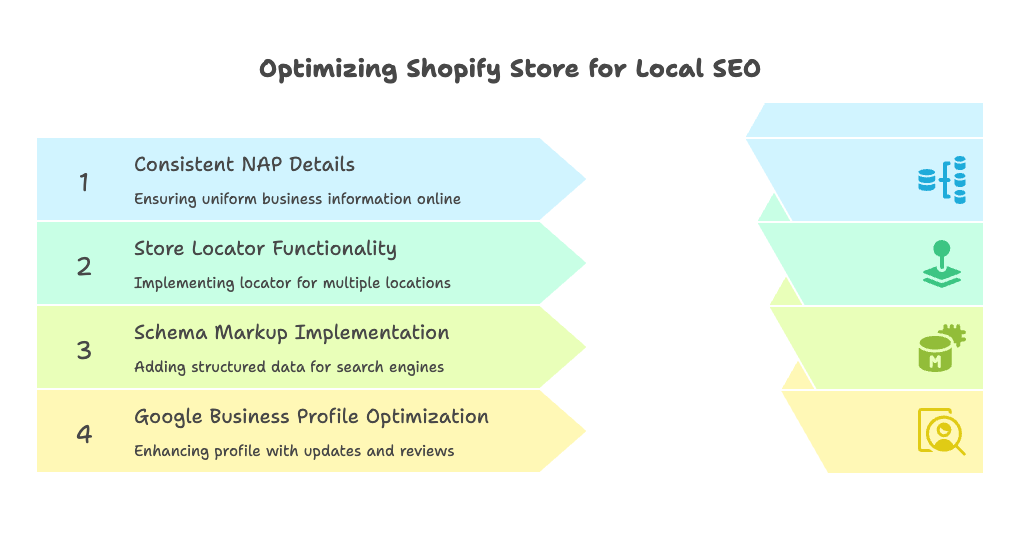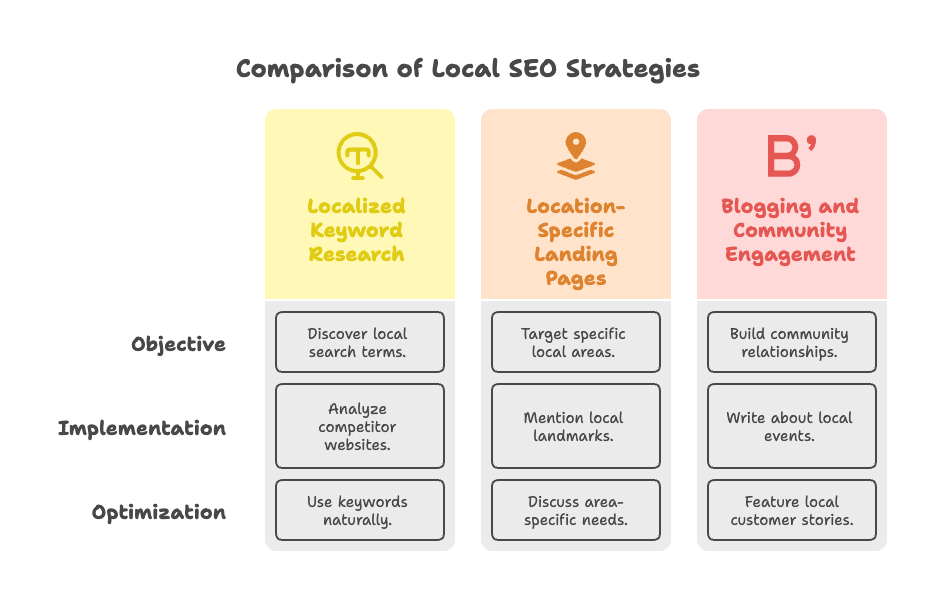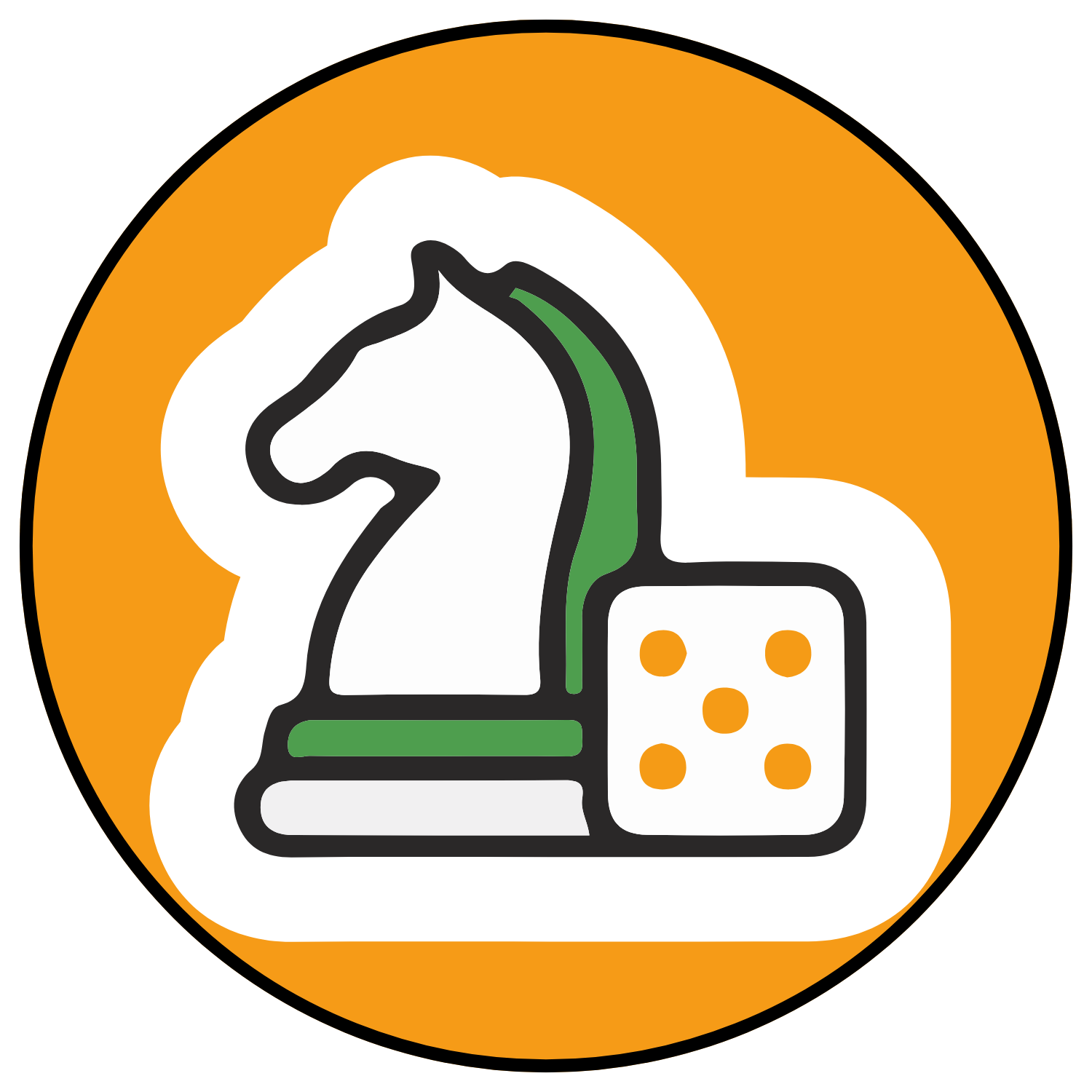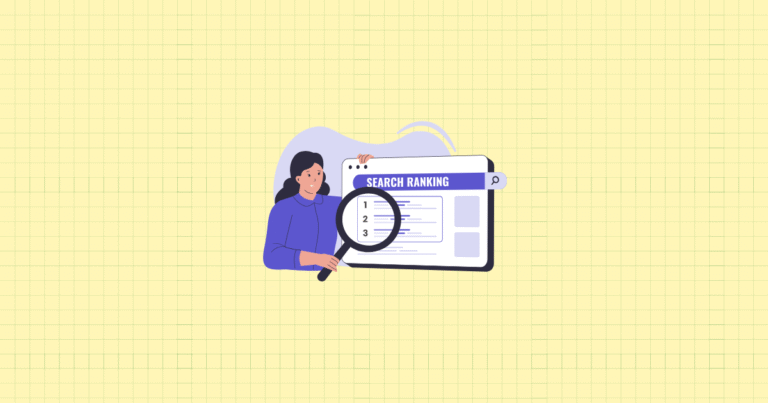Picture this: A potential customer is walking down your street, phone in hand, searching for exactly what you sell. They’re ready to buy. But here’s the kicker—will they find your Shopify store, or will they discover your competitor instead?
Local SEO isn’t just another marketing buzzword. It’s your secret weapon for capturing those high-intent, ready-to-purchase customers who are literally in your neighborhood. With nearly half of all Google searches carrying local intent, mastering local SEO for your Shopify store could be the difference between thriving and merely surviving in today’s competitive market.
In this comprehensive guide, we’ll walk you through everything you need to transform your Shopify store into a local search magnet. From setting up the fundamentals to implementing advanced tactics that your competitors probably don’t know about, you’ll discover how to dominate local search results and drive more qualified traffic to both your online store and physical locations.
Understanding Local SEO for Shopify

What Is Local SEO?
Local SEO is your digital storefront’s way of waving hello to nearby customers. But it’s more sophisticated than a simple wave—it’s a strategic approach to optimizing your online presence specifically for searches with geographic intent.
Think about it this way: when someone searches for “running shoes near me” or “jewelry store in downtown,” they’re not just browsing. They’re hunting. They have money in their pocket and a problem to solve, and they want to solve it locally. Local SEO ensures your Shopify store appears exactly when and where these motivated shoppers are looking.
This strategy works whether you’re running an online-only Shopify store targeting specific geographic regions or you have physical locations that complement your digital presence. The goal remains the same: connect with customers who are geographically relevant to your business.
Why Local SEO Matters for Shopify Stores
Here’s where things get interesting. Local SEO doesn’t just drive traffic—it drives the right traffic. These aren’t random browsers from across the globe; they’re local customers with genuine purchase intent.
When your store appears in Google’s Local Pack or Maps results, you’re not just getting visibility. You’re getting prime real estate in search results, often appearing above traditional organic listings. This elevated positioning translates to higher click-through rates and, more importantly, better conversion rates.
But here’s the challenge most Shopify store owners face: local SEO requires a different approach than traditional e-commerce SEO. You’re not just competing globally; you’re dominating locally. And that demands a unique strategy.
Key Components of Local SEO
Local SEO success rests on three fundamental pillars, each equally important and interconnected.
Google Business Profile serves as your digital business card. It’s not just a listing—it’s your chance to make a powerful first impression. This profile controls how you appear in local search results and Google Maps, making it absolutely critical to get right. Every detail matters, from your business hours to your latest photos.
Local keywords and content form the bridge between what customers search for and what you offer. But this isn’t about stuffing “near me” into every page title. It’s about understanding the specific ways your local customers search and creating content that genuinely serves their needs.
Citations and directory listings establish your credibility across the web. Think of citations as digital references—the more consistent and widespread they are, the more search engines trust that your business is legitimate and established in your local community.
Setting Up Your Shopify Store for Local SEO

Optimizing Store Information
Your store’s basic information forms the foundation of everything else. Get this wrong, and even the most sophisticated local SEO tactics won’t save you.
Consistent NAP details (Name, Address, Phone) must appear identically everywhere your business is mentioned online. This sounds simple, but it’s where many store owners stumble. Is your address “123 Main St.” on Google but “123 Main Street” on your website? That inconsistency confuses search engines and dilutes your local SEO power.
Add your NAP information to your Shopify store’s footer and create a dedicated “Contact Us” page. But don’t stop there—audit every platform where your business appears, from social media profiles to industry directories, ensuring perfect consistency.
If you have multiple locations, store locator functionality becomes essential. Shopify offers several apps that create professional store locators, but more importantly, you’ll want to develop unique pages for each location. These aren’t just directories—they’re opportunities to create locally-relevant content that serves both customers and search engines.
Schema markup might sound technical, but think of it as a translator between your website and search engines. It tells Google exactly what your business does, where it’s located, and when it’s open. Several Shopify apps can implement this markup without requiring coding knowledge.
Google Business Profile Optimization
Your Google Business Profile is often a customer’s first interaction with your brand. Make it count.
Claiming and completing your profile goes far beyond just filling out the basics. Choose the most specific business categories that apply to your store. Upload high-quality photos of your products, storefront, and team. Write a compelling business description that incorporates local keywords naturally.
Regular updates keep your profile active and engaging. Post about new products, special events, or seasonal promotions. Google rewards active profiles with better visibility, so consistent posting becomes a competitive advantage.
Managing reviews requires both proactive encouragement and reactive responsiveness. Don’t just wait for reviews to happen—create systems to request them. Send follow-up emails after purchases, include review requests with order confirmations, or train staff to ask satisfied customers for feedback.
When reviews do come in, respond to every single one. Positive reviews deserve thanks, while negative reviews offer opportunities to demonstrate excellent customer service publicly. Your responses show potential customers how you handle problems, which often matters more than the problems themselves.
On-Page and Content Strategies for Local SEO

Localized Keyword Research and Implementation
Local keyword research reveals a fascinating truth: people search differently when they’re looking for local businesses. They use phrases like “best coffee shop downtown” or “bike repair shop near the university.” These searches indicate strong purchase intent.
Start with Google Keyword Planner, but don’t stop there. Analyze your competitors’ websites to see what local terms they’re targeting. Look at the “People also ask” sections in search results for location-based queries. Pay attention to how your customers actually describe your products and location when they call or visit.
Optimizing Shopify pages with local keywords requires finesse. Your homepage might target broader terms like “handmade jewelry Chicago,” while individual product pages could focus on more specific phrases like “custom engagement rings Lincoln Park.”
Include local keywords in your page titles, meta descriptions, and headers, but always prioritize readability. Search engines are sophisticated enough to recognize keyword stuffing, and customers will bounce if your content feels unnatural.
Creating Locally Relevant Content
Content marketing for local SEO goes beyond product descriptions. You’re building relationships with your community, not just ranking for keywords.
Location-specific landing pages serve customers in different areas of your city or region. Each page should feel crafted specifically for that neighborhood or community. Mention local landmarks, discuss area-specific needs, and highlight any special services you offer in that location.
If you serve customers in different suburbs or districts, create pages that speak directly to each area’s unique character. A fitness store might discuss trail running opportunities near specific parks or cycling routes popular with local enthusiasts.
Blogging and community engagement content positions your store as an integral part of the local community. Write about local events your business sponsors or attends. Feature customer stories that highlight local connections. Collaborate with other local businesses on content that serves your shared customer base.
This approach creates content that local customers actually want to read while building valuable relationships with other businesses in your area. Both benefits compound over time, strengthening your local SEO foundation.
Off-Page Local SEO and Reputation Management
Building Local Citations and Backlinks
Think of citations as digital word-of-mouth recommendations. The more places that mention your business accurately, the more search engines trust that you’re a legitimate, established local business.
Submitting to local directories starts with the major platforms: Google, Yelp, Bing Places, and Apple Maps. But don’t overlook industry-specific directories and local business associations. A boutique clothing store might benefit from fashion directories, while a home goods store could gain value from local chamber of commerce listings.
The key is consistency. Every listing must use identical business information. Variations in your business name, address format, or phone number dilute the SEO value of citations and can confuse potential customers.
Acquiring local backlinks requires genuine relationship building. Partner with local bloggers to review your products or feature your business in gift guides. Sponsor community events in exchange for mentions on event websites. Collaborate with complementary businesses on joint promotions that naturally generate links.
Local news outlets often appreciate story ideas about interesting local businesses. If you have a unique founding story, innovative products, or community involvement, pitch these angles to local journalists and bloggers.
Managing Customer Reviews and Social Proof
Reviews serve as social proof, ranking factors, and customer service opportunities all rolled into one. Managing them effectively requires both systematic encouragement and thoughtful responses.
Encouraging customer reviews works best when it feels natural rather than pushy. Include gentle review requests in email receipts or shipping confirmations. Train staff to mention reviews during positive customer interactions. Consider offering small incentives like discount codes for customers who leave honest feedback.
Timing matters. Ask for reviews when customers are most satisfied—typically right after a positive interaction or when they receive a product they love. Don’t wait weeks after purchase when the excitement has faded.
Showcasing reviews on your Shopify store amplifies their impact beyond the original platform. Display positive reviews on product pages, especially those that mention specific benefits or uses. Create a dedicated testimonials page that highlights customer success stories.
Use Shopify review apps to automate the collection and display of reviews while maintaining control over which reviews appear where on your site.
Technical and Advanced Local SEO Tactics
Mobile Optimization and User Experience
Local searches happen predominantly on mobile devices. Someone walking downtown doesn’t fire up their laptop to find a nearby store—they pull out their phone. This reality makes mobile optimization absolutely critical for local SEO success.
Ensuring mobile responsiveness goes beyond basic functionality. Your Shopify theme must load quickly on mobile networks and provide an intuitive browsing experience. Test your site on various devices and connection speeds to identify any friction points that might cause potential customers to bounce.
Pay special attention to your contact information and store locator on mobile. These elements should be prominently displayed and easy to interact with. Include click-to-call phone numbers and one-tap directions to your store locations.
Optimizing for voice search addresses the growing trend of spoken queries. People ask voice assistants questions differently than they type them. Instead of typing “pizza restaurant,” they might ask “What’s the best pizza place near me that’s open now?”
Structure your content to answer these conversational queries. Create FAQ pages that address common spoken questions about your products, location, and services. Use natural language that matches how people actually speak, not just how they type.
Leveraging Shopify Apps and Integrations
The right apps can automate many local SEO tasks, freeing you to focus on strategy rather than manual implementation.
Store locator and local SEO apps offer sophisticated functionality beyond basic maps. Apps like Storemapper can generate location-specific pages automatically, implement proper schema markup, and even manage citations across multiple directories.
LocalRank and similar apps provide comprehensive local SEO audits, tracking your performance across various ranking factors and suggesting specific improvements. These tools can monitor your citations for accuracy and alert you to any inconsistencies that need correction.
Integrating with Google Business Profile through apps can sync your store data automatically. When you update store hours for the holidays or add new product photos, these changes can propagate across all your online listings without manual updating.
This automation prevents the inconsistencies that often develop when managing multiple platforms manually while ensuring your information stays current across all touchpoints.
Measuring and Improving Local SEO Performance
Tracking Local SEO Metrics
You can’t improve what you don’t measure. Local SEO metrics reveal which strategies are working and where opportunities for improvement exist.
Monitoring Google Business Profile insights provides direct feedback on how customers find and interact with your business listing. Track not just views and clicks, but also actions like phone calls, direction requests, and website visits generated from your profile.
Pay attention to the search terms that trigger your business to appear in results. These insights often reveal keyword opportunities you hadn’t considered and help you understand how customers actually describe your business and products.
Using Shopify Analytics and Google Analytics together creates a comprehensive view of your local SEO performance. Set up location-based segments to understand how local traffic behaves differently than general visitors. Track conversion rates from local search traffic to measure the business impact of your efforts.
Create custom reports that show traffic and conversions from specific geographic areas. This data helps you identify which locations generate the most valuable customers and deserve additional local SEO investment.
Continuous Improvement and Troubleshooting
Local SEO isn’t a set-it-and-forget-it strategy. Markets evolve, competitors adapt, and search algorithms change. Regular monitoring and adjustment keep your strategy effective.
Auditing local listings and citations regularly catches problems before they impact your rankings. Business information can change unexpectedly on directory sites, sometimes due to database errors or user submissions. Monthly audits help you identify and correct these issues quickly.
Use tools like Moz Local or BrightLocal to monitor your citations automatically and alert you to any inconsistencies that require attention.
Adjusting strategies based on data ensures your efforts focus on what actually drives results. If certain types of content generate more local engagement, create more of that content. If specific keywords drive higher conversion rates, optimize more pages for related terms.
Test new tactics systematically. Try different review request strategies, experiment with various types of local content, or test new citation sources. Measure the results carefully and double down on what works while discontinuing less effective approaches.
Conclusion and Next Steps
Local SEO for Shopify stores isn’t just about ranking higher in search results—it’s about building meaningful connections with customers in your community. Every optimization you make, from perfecting your Google Business Profile to creating locally relevant content, strengthens these connections while driving more qualified traffic to your store.
The strategies we’ve covered form a comprehensive system that works together. Your Google Business Profile attracts initial attention, your optimized website content converts visitors into customers, and your ongoing reputation management builds long-term relationships that drive repeat business and referrals.
Start with the fundamentals: claim and optimize your Google Business Profile, ensure consistent NAP information across all platforms, and create location-specific content that serves your local customers’ needs. These foundation elements will deliver immediate improvements while setting the stage for more advanced tactics.
Remember that local SEO success builds momentum over time. Stay committed to ongoing optimization, monitor your performance metrics regularly, and adapt your strategies based on what the data tells you. Your investment in local SEO today creates a sustainable competitive advantage that compounds month after month.
References
- Shopify. “Local SEO: What It Is and How To Do It (2024).” Shopify. https://www.shopify.com/retail/local-seo-retail
- YouTube. “How to Optimize a Shopify Web Page for Local SEO.” (2024). https://www.youtube.com/watch?v=gaVVW7AE6-o
- Storemapper. “Boosting Local SEO with Shopify Store Locators: Tips and Tricks.” (2024). https://www.storemapper.com/blog/boosting-local-seo-with-shopify-store-locators-tips-and-tricks
- StoreSEO. “Local SEO for eCommerce: A Complete Guide For Shopify.” (2024). https://storeseo.com/blog/local-seo-for-ecommerce/
- Refindable. “Guide to Local SEO strategies for Shopify stores.” (2025). https://refindable.com/blog/guide-to-local-seo-strategies-for-shopify-stores/
- Praella. “Shopify Local SEO Strategies: Boost Your Store’s Visibility.” (2024). https://praella.com/blogs/shopify-insights/shopify-local-seo-strategies-boost-your-stores-visibility
Ready to supercharge your Shopify store’s local visibility and drive more qualified traffic from your community? Growth Suite is a Shopify app that helps you optimize your conversion rates by presenting perfectly timed, personalized offers to visitors who need just a little extra incentive to purchase. Install it with a single click and start turning more local visitors into loyal customers today!




